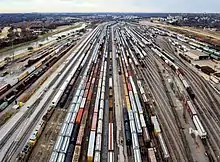Precision railroading
Precision railroading or precision scheduled railroading (PSR) is a concept in freight railroad operations pioneered by E. Hunter Harrison. It shifts the focus from older practices, such as unit trains, hub and spoke operations and individual car switching at hump yards, to emphasize point-to-point freight car movements on simplified routing networks. Under PSR, freight trains operate on fixed schedules, much like passenger trains, instead of being dispatched whenever a sufficient number of loaded cars are available. In the past, container trains and general merchandise trains operated separately; under PSR they are combined as needed. Inventories of freight cars and locomotives are reduced and fewer workers are employed for a given level of traffic. The result is often substantial improvement in railroad operating ratios, and other financial and operating metrics. Variations on the method have been adopted by most North American Class I railroads, with the notable exception of BNSF, as of 2019.

Harrison first introduced PSR at the Illinois Central Railroad (IC), where he became CEO in 1993. He implemented it at Canadian National after they acquired IC in 1998. After retiring from Canadian National, Harrison was recruited to take over leadership of the Canadian Pacific and implemented precision railroading there. In March 2017, he was appointed CEO of CSX Transportation and began implementing PSR on its large network, but he died eight months later. His successors have continued his PSR program.[1]
Precision railroading has been criticized on many fronts. Shippers complain about poorer service and confusion during the transition. Under PSR, service is typically eliminated on shipping lanes, origin-destination pairs, that have low traffic levels. Intermodal terminals have been consolidated, with the railroad relying on trucks for the last hundred miles.[2] Fewer workers are needed, even with higher traffic volumes. [3] As a result, over 20,000 railroad workers have been laid off in 2019.[4] PSR advocates claim that shippers benefit in the long run from reduced costs and more reliable schedules.
Railroads that have implemented precision railroading include Union Pacific, CSX, Norfolk Southern, Canadian National, Canadian Pacific, and Kansas City Southern.
References
- Barrow, Keith (September 17, 2019). "Precision Scheduled Railroading Evolution-Revolution". International Railway Journal.
- Ashe, Ari (April 5, 2019). "Jury still out on 'precision' railroading in US". Joc.com.
- Stephens, Bill (June 26, 2019). "Impact of Precision Scheduled Railroading shows up in Class I employment figures". Trains Magazine.
- https://www.washingtonpost.com/business/economy/railroads-are-slashing-workers-cheered-on-by-wall-street-to-stay-profitable-amid-trumps-trade-war/2020/01/02/dc757ed4-1603-11ea-a659-7d69641c6ff7_story.html